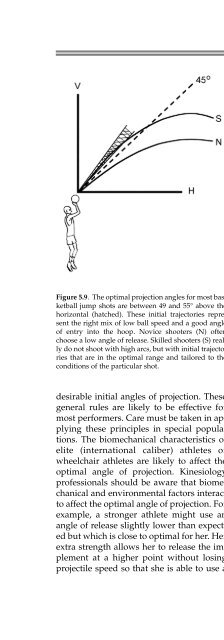Fundamentals of Biomechanics
Fundamentals of Biomechanics
Fundamentals of Biomechanics
Create successful ePaper yourself
Turn your PDF publications into a flip-book with our unique Google optimized e-Paper software.
Figure 5.9. The optimal projection angles for most basketball<br />
jump shots are between 49 and 55° above the<br />
horizontal (hatched). These initial trajectories represent<br />
the right mix <strong>of</strong> low ball speed and a good angle<br />
<strong>of</strong> entry into the hoop. Novice shooters (N) <strong>of</strong>ten<br />
choose a low angle <strong>of</strong> release. Skilled shooters (S) really<br />
do not shoot with high arcs, but with initial trajectories<br />
that are in the optimal range and tailored to the<br />
conditions <strong>of</strong> the particular shot.<br />
desirable initial angles <strong>of</strong> projection. These<br />
general rules are likely to be effective for<br />
most performers. Care must be taken in applying<br />
these principles in special populations.<br />
The biomechanical characteristics <strong>of</strong><br />
elite (international caliber) athletes or<br />
wheelchair athletes are likely to affect the<br />
optimal angle <strong>of</strong> projection. Kinesiology<br />
pr<strong>of</strong>essionals should be aware that biomechanical<br />
and environmental factors interact<br />
to affect the optimal angle <strong>of</strong> projection. For<br />
example, a stronger athlete might use an<br />
angle <strong>of</strong> release slightly lower than expected<br />
but which is close to optimal for her. Her<br />
extra strength allows her to release the implement<br />
at a higher point without losing<br />
projectile speed so that she is able to use a<br />
CHAPTER 5: LINEAR AND ANGULAR KINEMATICS 121<br />
slightly lower angle <strong>of</strong> release. Pr<strong>of</strong>essionals<br />
coaching projectile sports must keep<br />
up on the biomechanical research related to<br />
optimal conditions for their athletes.<br />
ANGULAR MOTION<br />
Angular kinematics is the description <strong>of</strong><br />
angular motion. Angular kinematics is particularly<br />
appropriate for the study <strong>of</strong> human<br />
movement because the motion <strong>of</strong> most<br />
human joints can be described using one,<br />
two, or three rotations. Angular kinematics<br />
should also be easy for biomechanics students<br />
because for every linear kinematic<br />
variable there is a corresponding angular<br />
kinematic variable. It will even be easy to<br />
distinguish angular from linear kinematics<br />
because the adjective “angular” or a Greek<br />
letter symbol is used instead <strong>of</strong> the Arabic<br />
letters used for linear kinematics.<br />
Angular displacement (: theta) is the<br />
vector quantity representing the change in<br />
angular position <strong>of</strong> an object. Angular displacements<br />
are measured in degrees, radians<br />
(dimensionless unit equal to 57.3º), and<br />
revolutions (360º). The usual convention to<br />
keep directions straight and be consistent<br />
with our 2D linear kinematic calculations is<br />
to consider counterclockwise rotations as<br />
positive. Angular displacement measured<br />
with a goniometer is one way to measure<br />
static flexibility. As in linear kinematics,<br />
the frames <strong>of</strong> reference for these angular<br />
measurements are different. Some tests define<br />
complete joint extension as 0º while<br />
other test refer to that position as 180º. For<br />
a review <strong>of</strong> several physical therapy static<br />
flexibility tests, see Norkin & White (1995).<br />
In analyzing the curl-up exercise<br />
shown in Figure 5.10, the angle between<br />
the thoracic spine and the floor is <strong>of</strong>ten<br />
used. This exercise is usually limited to the<br />
first 30 to 40º above the horizontal to limit<br />
the involvement <strong>of</strong> the hip flexors<br />
(Knudson, 1999a). The angular displacement<br />
<strong>of</strong> the thoracic spine in the eccen-






